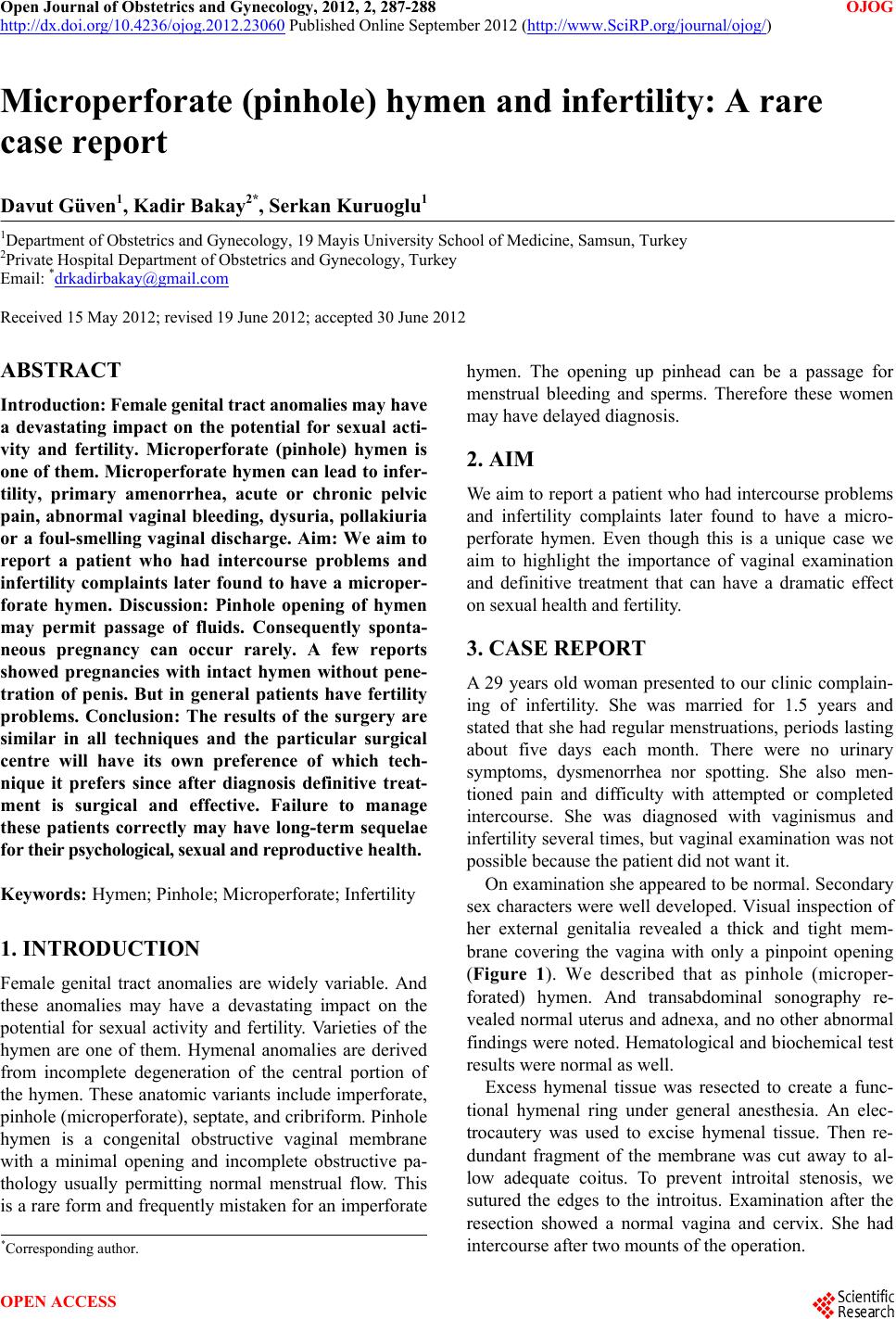
Open Journal of Obstetrics and Gynecology, 2012, 2, 287-288 OJOG
http://dx.doi.org/10.4236/ojog.2012.23060 Published Online September 2012 (http://www.SciRP.org/journal/ojog/)
Microperforate (pinhole) hymen and infertility: A rare
case report
Davut Güven1, Kadir Bakay2*, Serkan Kuruoglu1
1Department of Ob s tetrics and Gynecology, 19 Mayis University School of Medicine, Samsun, Turkey
2Private Hospital Department of Obstetrics and Gynecology, Turkey
Email: *drkadirbakay@gmail.com
Received 15 May 2012; revised 19 June 2012; accepted 30 June 2012
ABSTRACT
Introduction: Female genital tract anomalies may have
a devastating impact on the potential for sexual acti-
vity and fertility. Microperforate (pinhole) hymen is
one of them. Microperforate hymen can lead to infer-
tility, primary amenorrhea, acute or chronic pelvic
pain, abnormal vaginal bleeding, dysuria, pollakiuria
or a foul-smelling vaginal discharge. Aim: We aim to
report a patient who had intercourse problems and
infertility complaints later found to have a microper-
forate hymen. Discussion: Pinhole opening of hymen
may permit passage of fluids. Consequently sponta-
neous pregnancy can occur rarely. A few reports
showed pregnancies with intact hymen without pene-
tration of penis. But in general patients have fertility
problems. Conclusion: The results of the surgery are
similar in all techniques and the particular surgical
centre will have its own preference of which tech-
nique it prefers since after diagnosis definitive treat-
ment is surgical and effective. Failure to manage
these patients correctly may have long-term sequelae
for their psych ologic al, se xual an d reproductive health.
Keywords: Hymen; Pinhole; Microperforate; Infertility
1. INTRODUCTION
Female genital tract anomalies are widely variable. And
these anomalies may have a devastating impact on the
potential for sexual activity and fertility. Varieties of the
hymen are one of them. Hymenal anomalies are derived
from incomplete degeneration of the central portion of
the hymen. These anatomic variants include imperforate,
pinhole (microperforate), septate, and cribriform. Pinhole
hymen is a congenital obstructive vaginal membrane
with a minimal opening and incomplete obstructive pa-
thology usually permitting normal menstrual flow. This
is a rare form and frequently mistaken for an imperforate
hymen. The opening up pinhead can be a passage for
menstrual bleeding and sperms. Therefore these women
may have delayed diagnosis.
2. AIM
We aim to repor t a patient who had intercourse pro blems
and infertility complaints later found to have a micro-
perforate hymen. Even though this is a unique case we
aim to highlight the importance of vaginal examination
and definitive treatment that can have a dramatic effect
on sexual health and fertility.
3. CASE REPORT
A 29 years old woman presented to our clinic complain-
ing of infertility. She was married for 1.5 years and
stated that she had regular menstruations, periods lasting
about five days each month. There were no urinary
symptoms, dysmenorrhea nor spotting. She also men-
tioned pain and difficulty with attempted or completed
intercourse. She was diagnosed with vaginismus and
infertility several times, but vagin al examination was not
possible because the patient did not want it.
On examination she appeared to be normal. Secondary
sex characters were well developed. Visual inspection of
her external genitalia revealed a thick and tight mem-
brane covering the vagina with only a pinpoint opening
(Figure 1). We described that as pinhole (microper-
forated) hymen. And transabdominal sonography re-
vealed normal uterus and adnexa, and no other abnormal
findings were noted. Hematological and biochemical test
results were normal as well.
Excess hymenal tissue was resected to create a func-
tional hymenal ring under general anesthesia. An elec-
trocautery was used to excise hymenal tissue. Then re-
dundant fragment of the membrane was cut away to al-
low adequate coitus. To prevent introital stenosis, we
sutured the edges to the introitus. Examination after the
resection showed a normal vagina and cervix. She had
intercourse after two mounts of the operation.
*Corresponding a uthor.
OPEN ACCESS